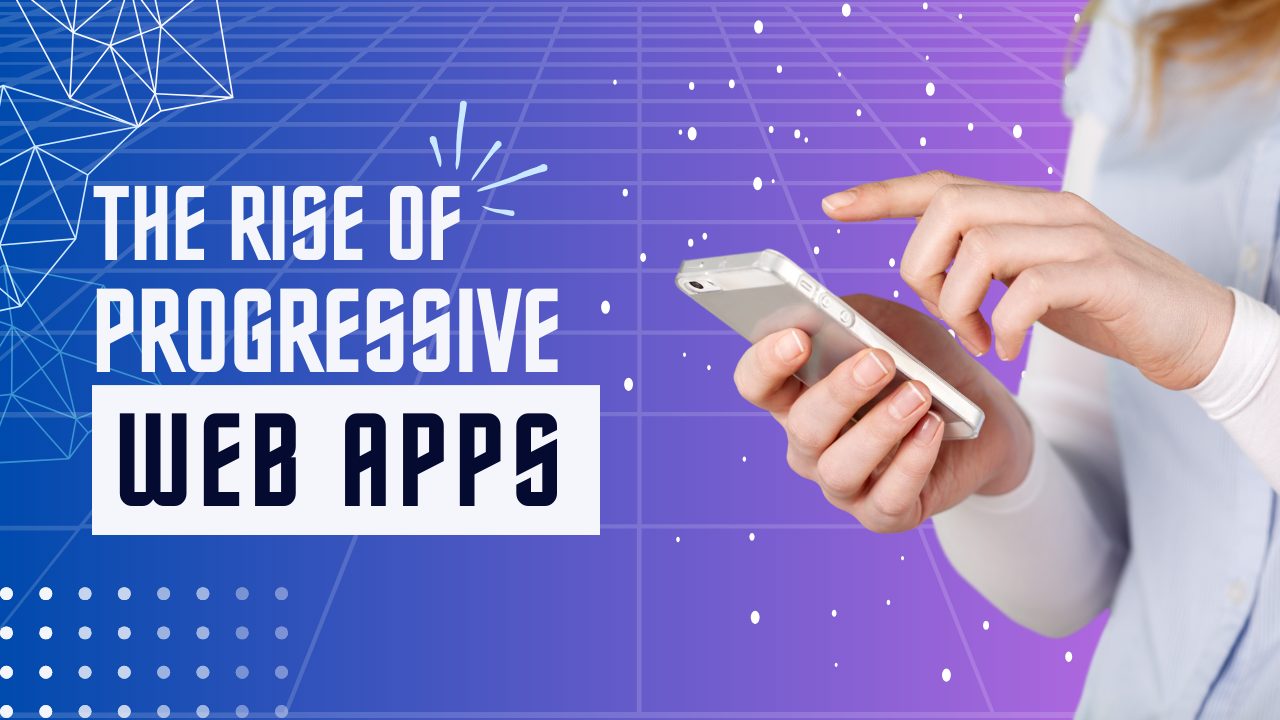Progressive Web Apps (PWAs) are gaining massive traction in 2024, reshaping how businesses and developers approach app development. From The Rise of Progressive Web Apps, PWAs combine the best of both web and mobile applications, offering a seamless experience that bridges the gap between traditional websites and native mobile apps. This cutting-edge technology provides speed, reliability, and engagement while being cost-effective and user-friendly.
As we step further into a mobile-first world, businesses are looking for ways to enhance their digital presence without incurring excessive costs. PWAs are emerging as the go-to solution, providing unmatched functionality and performance. This article explores the trends shaping the rise of PWAs and why they are becoming essential for businesses in 2024.
Progressive Web Apps – What are they?

Progressive Web Apps are web applications that function like native mobile apps, delivering a rich user experience through modern web capabilities. Built using standard web technologies like HTML, CSS, and JavaScript, PWAs offer features such as offline functionality, push notifications, and smooth transitions, making them a powerful alternative to traditional apps.
What sets PWAs apart is their ability to work across all devices and platforms. Users can access them through a web browser without downloading them from an app store. This ease of use, coupled with their versatility, makes PWAs a game-changer for businesses looking to enhance accessibility and engagement. In essence, PWAs offer the speed and performance of an app while retaining the simplicity and reach of a website.
Speed and Performance: Quicker Than a Bullet
Speed is a critical factor for any digital experience, and PWAs excel in this area. By using advanced caching techniques, PWAs load quickly, even on slow networks. This speed not only enhances user satisfaction but also reduces bounce rates, ensuring users stay engaged with the app longer.
Additionally, PWAs are designed to prioritize performance. They load instantly after the first visit, creating an app-like experience without the typical delays associated with traditional websites. For businesses, this means providing a faster and smoother experience for users, ultimately driving better engagement and conversions. (Latest statistics on mobile web usage)
Better User Experience: Ooh la la, Butter like Smooth transition

User experience is at the core of PWAs, with smooth transitions and intuitive interfaces that mimic native apps. The responsive design ensures that PWAs adapt seamlessly to various screen sizes, providing a consistent experience across devices.
PWAs also eliminate common frustrations, such as waiting for app updates or dealing with platform-specific issues. The app updates automatically in the background, ensuring users always have the latest version. This focus on user satisfaction makes PWAs an appealing choice for businesses aiming to deliver top-notch experiences. (Why user experience is key in web design)
Offline Capabilities: Functioning While Being Offline
One of the standout features of PWAs is their ability to function offline. Through service workers, a key technology behind PWAs, users can access content even without an internet connection. This is particularly useful for businesses that want to ensure uninterrupted access to their services.
Offline capabilities not only improve accessibility but also enhance user trust. Whether it’s browsing a product catalog or reading an article, users can continue their activities without worrying about connectivity issues. This feature gives PWAs a significant advantage over traditional websites, making them indispensable in today’s fast-paced world. (How service workers enhance PWA performance)
One size fits all cross-platform compatibility
Unlike native apps, which require separate development for different platforms, PWAs are designed to work on any device with a browser. This cross-platform compatibility simplifies the development process and reduces costs, making PWAs a practical choice for businesses of all sizes.
For users, this means a seamless experience across devices, whether they’re using a smartphone, tablet, or desktop. Businesses benefit from reaching a wider audience without the complexities of maintaining multiple versions of their app. This universality makes PWAs an efficient and future-proof solution.
Cost Savings-Penny Wise, Pound Foolish

Developing native apps can be expensive, especially for small businesses with limited budgets. PWAs offer a cost-effective alternative by eliminating the need for separate development teams for different platforms. With a single codebase, businesses can create an app that works across all devices.
Moreover, PWAs reduce ongoing maintenance costs. Updates are handled centrally, eliminating the need for users to download new versions. This not only saves money but also ensures that all users have access to the latest features and improvements. For businesses, PWAs provide a high return on investment without compromising on quality.
Push Notifications: To Keep Users Engaged
Engaging users and keeping them informed is crucial for any business, and PWAs excel in this area with push notifications. These messages can be sent directly to users’ devices, providing timely updates, promotions, or reminders that drive engagement.
Push notifications are a powerful tool for re-engaging users who may have abandoned the app. They allow businesses to deliver personalized content that resonates with their audience, increasing the likelihood of conversions. For small and large businesses alike, this feature adds immense value to their digital strategy.
Summary: Security Keeping Our Data Safe

Security is a top priority in today’s digital landscape, and PWAs are designed with robust security measures. By serving content over HTTPS, they ensure data integrity and protect users from potential threats. This is particularly important for businesses handling sensitive information, such as payment details or personal data.
Additionally, PWAs leverage modern security protocols to safeguard user information. This focus on security not only builds trust but also aligns with industry standards, making PWAs a reliable choice for businesses looking to protect their customers and their brand.
Flexible and Personalized: Your Own Version
One of the strengths of PWAs is their flexibility. Businesses can tailor these apps to meet their specific needs, whether it’s creating a unique interface or integrating specialized features. This personalization ensures that the app aligns with the brand identity and user expectations.
Moreover, PWAs can adapt to user behavior, providing a more customized experience. By analyzing user interactions, businesses can optimize their app to deliver relevant content and features. This level of personalization enhances user satisfaction and drives long-term engagement.
Benefits in SEO: Improving Visibility

Search engine optimization (SEO) plays a crucial role in digital success, and PWAs are designed to improve visibility. Their fast loading times, mobile-friendliness, and structured data make them highly discoverable by search engines, ensuring better rankings and increased traffic.
Unlike native apps, which are often hidden behind app store walls, PWAs are indexed by search engines, making them accessible to a wider audience. For businesses, this means greater reach and better opportunities to connect with potential customers. By leveraging PWAs, businesses can enhance their online presence and achieve their marketing goals. (Read about Starbucks’ success with their PWA)
Integration with Modern Technologies – Embracing Innovation
PWAs are built to integrate seamlessly with modern technologies, such as artificial intelligence (AI) and the Internet of Things (IoT). This compatibility allows businesses to enhance their apps with advanced features like voice recognition, predictive analytics, and real-time data synchronization.
These integrations not only improve functionality but also future-proof the app, ensuring it remains relevant as new technologies emerge. For businesses, adopting PWAs means staying ahead of the curve and delivering cutting-edge experiences to their users.
Major Brands Leading By Example

Many leading brands have embraced PWAs, showcasing their potential to revolutionize digital experiences. Companies like Twitter, Starbucks, and Pinterest have adopted PWAs to enhance user engagement, reduce load times, and improve accessibility.
These success stories highlight the effectiveness of PWAs in driving business growth. By following the lead of these industry giants, businesses can leverage PWAs to achieve similar results and stay competitive in an increasingly digital world.
In Conclusion
2024 – Progressive Web Apps revolutionize the internet by focusing on speed, reliability, and more awesome user experiences. PWAs are more cost-effective, compatible with various platforms, and can be integrated with innovative features and heightened security, which are in general benefits that no business can afford to ignore.
Therefore, if you wish to remain invincible in this digital shoulder-to-shoulder game, you must hop on the PWA bandwagon. Prepare yourself to change the way your organization looks online and the way your users interface with it. You never know, your PWA could be the next big thing and everyone would be raving about it.

